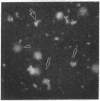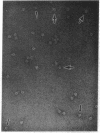Abstract
A method is described to deliver 235U to tumors; the isotope would then be fissioned by incident neutrons, producing localized lethal radiation sufficient for therapy. Apoferritin was loaded with an average of approximately 800 238U atoms per molecule. Stability of the loaded apoferritin in solution was improved, so that only 8% loss of uranium occurred after 8 days at pH 7. Fab' antibody fragments were covalently attached to the uranium-loaded apoferritin, and the immunoreactivity of the conjugate was 92% of that for antibody alone. Such bio-uranium constructions should provide significant advantages over boronated antibodies to meet the requirements for clinical neutron-capture therapy.
Full text
PDF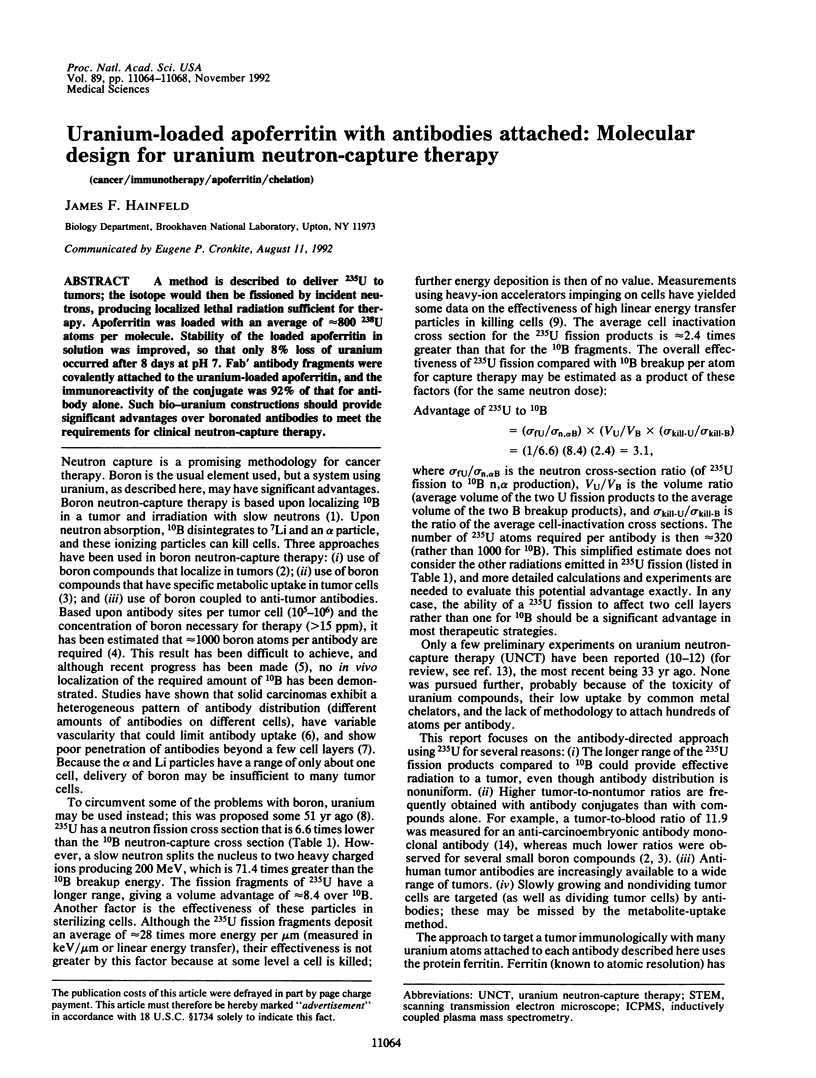
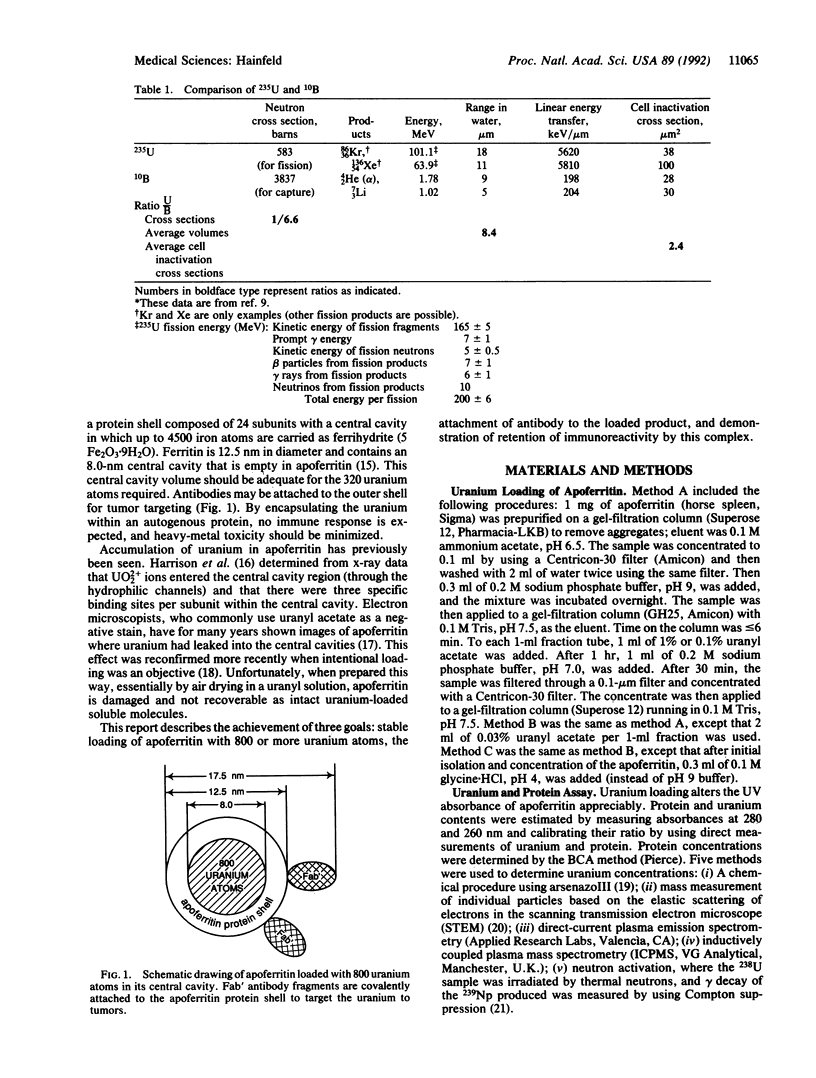
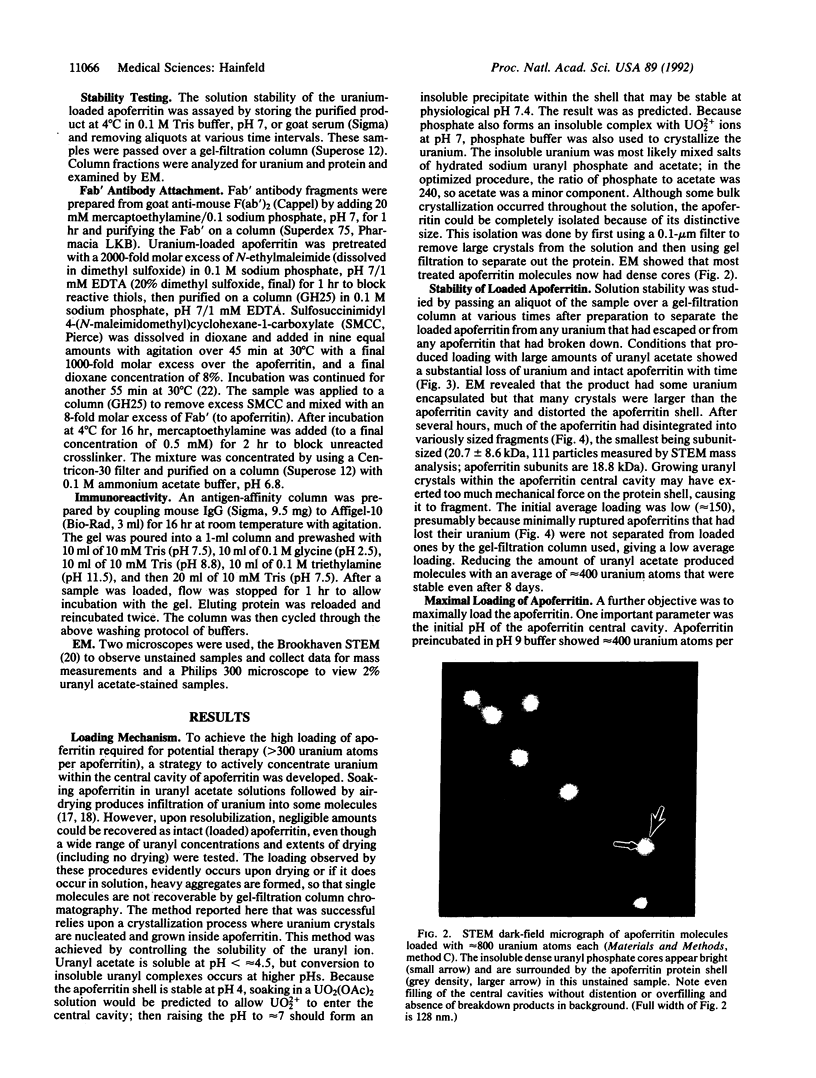
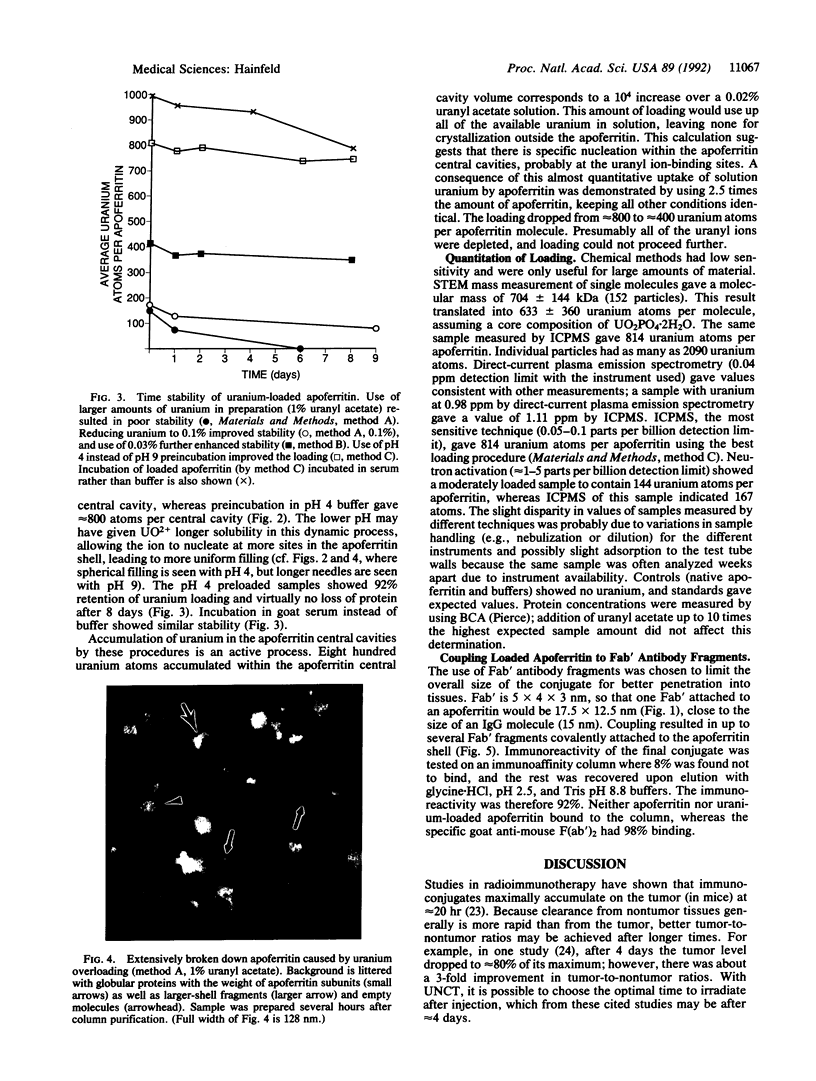
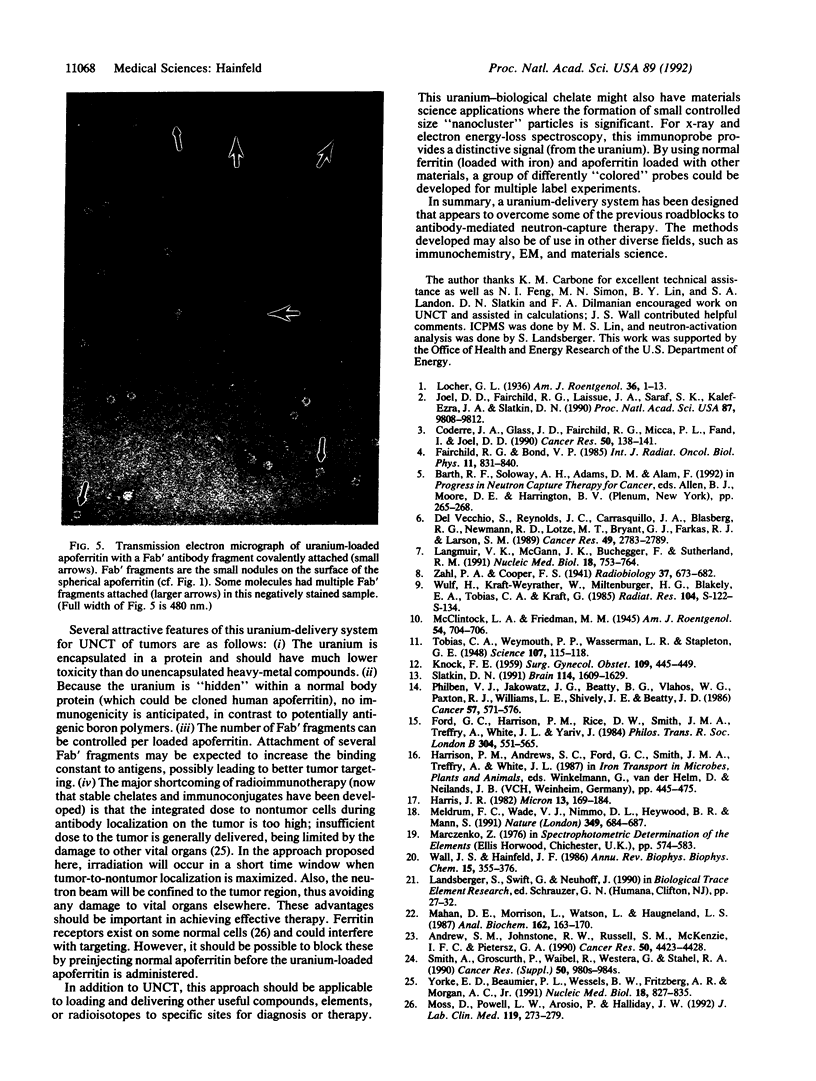
Images in this article
Selected References
These references are in PubMed. This may not be the complete list of references from this article.
- Andrew S. M., Johnstone R. W., Russell S. M., McKenzie I. F., Pietersz G. A. Comparison of in vitro cell binding characteristics of four monoclonal antibodies and their individual tumor localization properties in mice. Cancer Res. 1990 Jul 15;50(14):4423–4428. [PubMed] [Google Scholar]
- Coderre J. A., Glass J. D., Fairchild R. G., Micca P. L., Fand I., Joel D. D. Selective delivery of boron by the melanin precursor analogue p-boronophenylalanine to tumors other than melanoma. Cancer Res. 1990 Jan 1;50(1):138–141. [PubMed] [Google Scholar]
- Del Vecchio S., Reynolds J. C., Carrasquillo J. A., Blasberg R. G., Neumann R. D., Lotze M. T., Bryant G. J., Farkas R. J., Larson S. M. Local distribution and concentration of intravenously injected 131I-9.2.27 monoclonal antibody in human malignant melanoma. Cancer Res. 1989 May 15;49(10):2783–2789. [PubMed] [Google Scholar]
- Fairchild R. G., Bond V. P. Current status of 10B-neutron capture therapy: enhancement of tumor dose via beam filtration and dose rate, and the effects of these parameters on minimum boron content: a theoretical evaluation. Int J Radiat Oncol Biol Phys. 1985 Apr;11(4):831–840. doi: 10.1016/0360-3016(85)90318-9. [DOI] [PubMed] [Google Scholar]
- Ford G. C., Harrison P. M., Rice D. W., Smith J. M., Treffry A., White J. L., Yariv J. Ferritin: design and formation of an iron-storage molecule. Philos Trans R Soc Lond B Biol Sci. 1984 Feb 13;304(1121):551–565. doi: 10.1098/rstb.1984.0046. [DOI] [PubMed] [Google Scholar]
- Joel D. D., Fairchild R. G., Laissue J. A., Saraf S. K., Kalef-Ezra J. A., Slatkin D. N. Boron neutron capture therapy of intracerebral rat gliosarcomas. Proc Natl Acad Sci U S A. 1990 Dec;87(24):9808–9812. doi: 10.1073/pnas.87.24.9808. [DOI] [PMC free article] [PubMed] [Google Scholar]
- KNOCK F. E. Perfusion of uranium-antibody complexes for the neutron capture therapy of tumors. Surg Gynecol Obstet. 1959 Oct;109:445–449. [PubMed] [Google Scholar]
- Langmuir V. K., McGann J. K., Buchegger F., Sutherland R. M. The effect of antigen concentration, antibody valency and size, and tumor architecture on antibody binding in multicell spheroids. Int J Rad Appl Instrum B. 1991;18(7):753–764. doi: 10.1016/0883-2897(91)90014-c. [DOI] [PubMed] [Google Scholar]
- Mahan D. E., Morrison L., Watson L., Haugneland L. S. Phase change enzyme immunoassay. Anal Biochem. 1987 Apr;162(1):163–170. doi: 10.1016/0003-2697(87)90023-6. [DOI] [PubMed] [Google Scholar]
- Moss D., Powell L. W., Arosio P., Halliday J. W. Characterization of the ferritin receptors of human T lymphoid (MOLT-4) cells. J Lab Clin Med. 1992 Mar;119(3):273–279. [PubMed] [Google Scholar]
- Philben V. J., Jakowatz J. G., Beatty B. G., Vlahos W. G., Paxton R. J., Williams L. E., Shively J. E., Beatty J. D. The effect of tumor CEA content and tumor size on tissue uptake of indium 111-labeled anti-CEA monoclonal antibody. Cancer. 1986 Feb 1;57(3):571–576. doi: 10.1002/1097-0142(19860201)57:3<571::aid-cncr2820570329>3.0.co;2-b. [DOI] [PubMed] [Google Scholar]
- Slatkin D. N. A history of boron neutron capture therapy of brain tumours. Postulation of a brain radiation dose tolerance limit. Brain. 1991 Aug;114(Pt 4):1609–1629. doi: 10.1093/brain/114.4.1609. [DOI] [PubMed] [Google Scholar]
- Smith A., Groscurth P., Waibel R., Westera G., Stahel R. A. Imaging and therapy of small cell carcinoma xenografts using 131I-labeled monoclonal antibody SWA11. Cancer Res. 1990 Feb 1;50(3 Suppl):980s–984s. [PubMed] [Google Scholar]
- Tobias C. A., Weymouth P. P., Wasserman L. R., Stapleton G. E. Some Biological Effects Due to Nuclear Fission. Science. 1948 Jan 30;107(2770):115–118. doi: 10.1126/science.107.2770.115. [DOI] [PubMed] [Google Scholar]
- Wall J. S., Hainfeld J. F. Mass mapping with the scanning transmission electron microscope. Annu Rev Biophys Biophys Chem. 1986;15:355–376. doi: 10.1146/annurev.bb.15.060186.002035. [DOI] [PubMed] [Google Scholar]
- Yorke E. D., Beaumier P. L., Wessels B. W., Fritzberg A. R., Morgan A. C., Jr Optimal antibody-radionuclide combinations for clinical radioimmunotherapy: a predictive model based on mouse pharmacokinetics. Int J Rad Appl Instrum B. 1991;18(8):827–835. doi: 10.1016/0883-2897(91)90090-8. [DOI] [PubMed] [Google Scholar]




